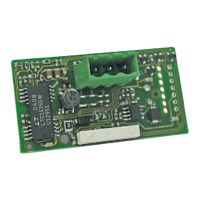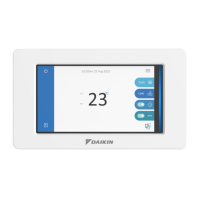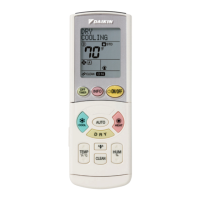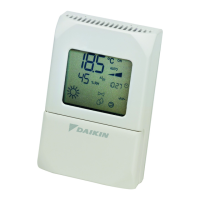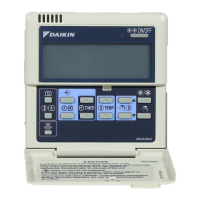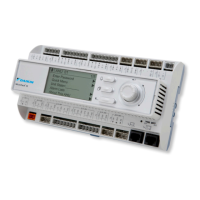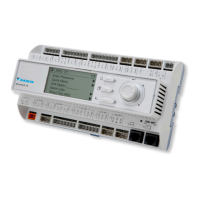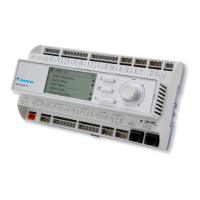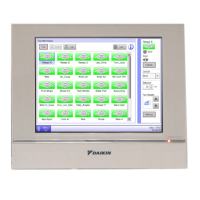BACnet Quick-Start Sequence
The following steps summarize the process for enabling and
conguring BACnet on the MD4:
1. Enable BACnet protocol: Set drive parameter 9802,
COMM PROTOCOL SEL = BACNET (5).
NOTE: If you cannot see the desired selection on the panel,
your drive does not have that protocol software in the
application memory.
• To conrm this selection, read drive parameter 5301,
EFB PROTOCOL ID. It should read x5xx (where “x” is
any value).
2. Place the BACnet channel in “reset”: Set drive parameter
5302, EFB STATION ID = 0.
• This setting holds the BACnet communication channel
in reset while remaining settings are completed.
3. Dene the MS/TP baud rate.
• Set drive parameter 5303, EFB BAUD RATE =
appropriate value.
4. Dene the Device Object Instance ID.
• To dene a specic device object instance value,
use drive parameters 5311 and 5317 (object
instance values must be unique and in the range 1 to
4,194,303).
• To use the drive’s MS/TP MAC ID as the device object
instance value, set drive parameter 5311 and 5317 =
0.
5. Dene a unique MS/TP MAC ID. Set drive parameter
5302, EFB STATION ID = appropriate value.
• Once this parameter is set to a non-zero value,
current BACnet settings are “latched” and used for
communication until the channel is reset.
• In order to participate in MS/TP token passing, the
MAC ID used must be within the limits dened by
other masters’ “Max Master” property.
6. Conrm proper BACnet communication.
• When BACnet communication is operating properly,
drive parameter 5316, EFB PAR 16 (the MS/TP token
counter), should be continually increasing.
• Drive parameter 5306, UART ERRORS, should be
stable.
Protocol Implementation Conformance Statement (PICS)
PICS Summary
BACnet Standard Device Prole
This version of MD4 BACnet fully conforms to the ‘Application-
Specic Controller’ standard device prole (B-ASC).
Services Supported
The following services are supported by the MD4:
• I-Am (Response to Who-Is, also broadcast on power-up
& other reset)
• I-Have (Response to Who-Has)
• ReadProperty
• WriteProperty
• DeviceCommunicationControl
• ReinitializeDevice
Data Link Layer
The MD4 implements MS/TP (Master) Data Link Layer. All
standard MS/TP baud rates are supported (9600, 19200,
38400 & 76800).
MAC ID / Device Object Instance
The MD4 supports separate MAC ID and Device Object
Instance parameters:
• Set the MAC ID using drive parameter 5302. Default:
5302 = 12?.
• Set the Device Object Instance ID using drive parameters
5311 and 5317.
Default: Both 5311 and 5317 = 0, which causes the MAC
ID to “double” as the Device Object Instance. For Device
Object Instance values not linked to the MAC ID, set ID
values using 5311 and 5317:
— For IDs in the range 1 to 65,535: Parameter 5311sets
the ID directly (5317 must be 0). For example, the
following values set the ID to 49,134: 5311 = 49134
and 5317 = 0.
— For IDs > 65,335: The ID equals 5311’s value plus
10,000 times 5317’s value. For example, the following
values set the ID to 71,234: 5311 = 1234 and 5317 =
7.
Max Info Frames Property
Congure the Device Object Max Info Frames property using
drive parameter 5312. Default: 5312 = 1.
Max Master Property
Congure the Device Object Max Master property using drive
parameter 5313. Default: 5313 = 127.
MS/TP Token Counter
Parameter 5316 stores the count of MS/TP tokens passed to
the associated node.
fIeldbus ConTrols
www.DaikinApplied.com 87 OM 1190-1 • MD4 VFD
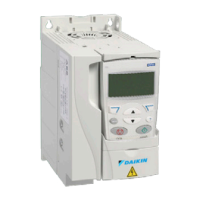
